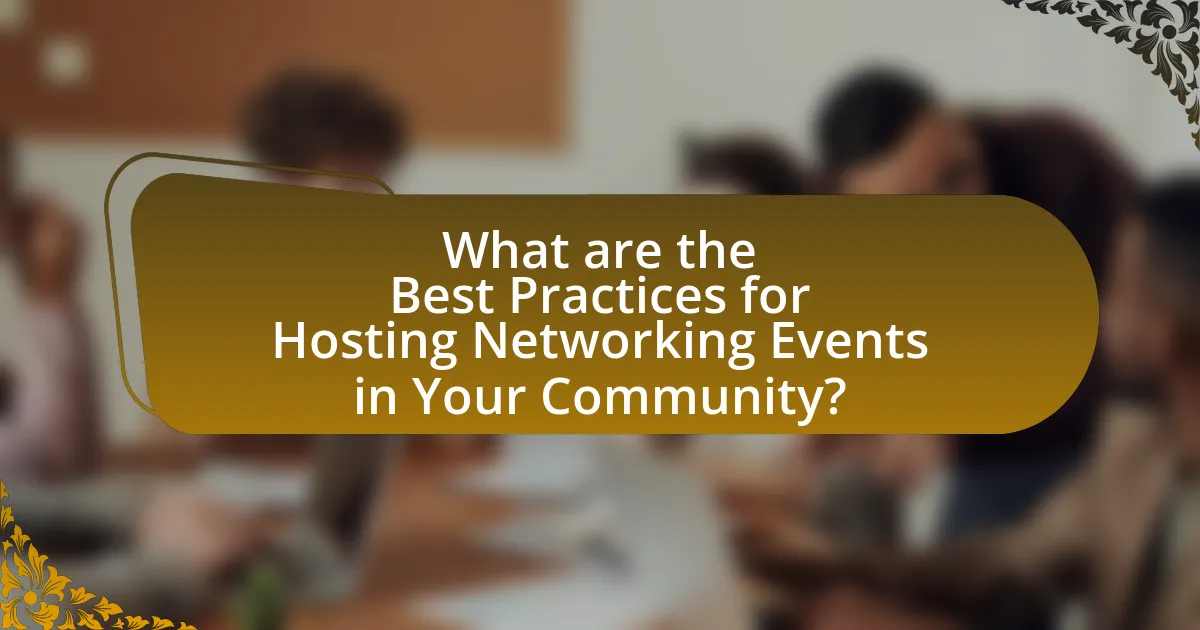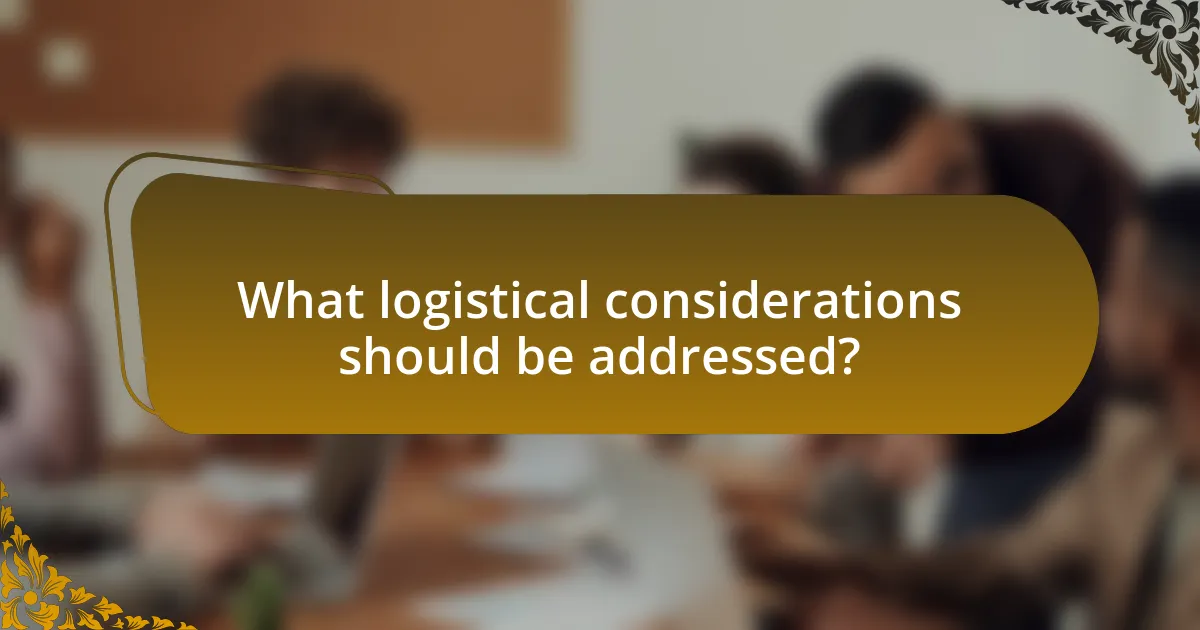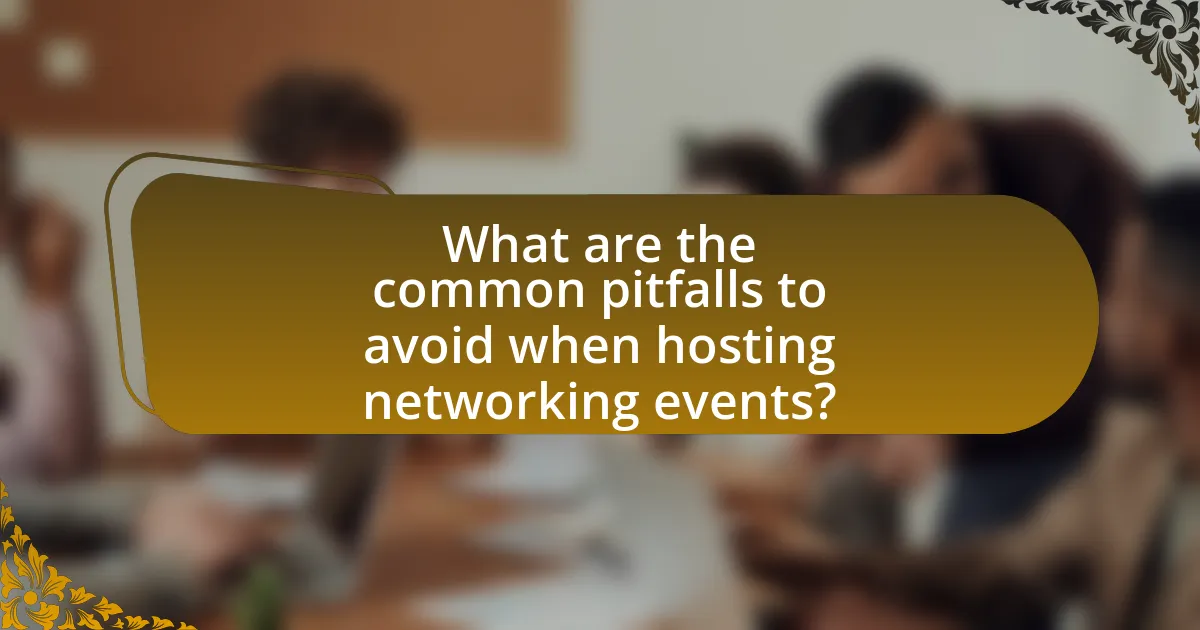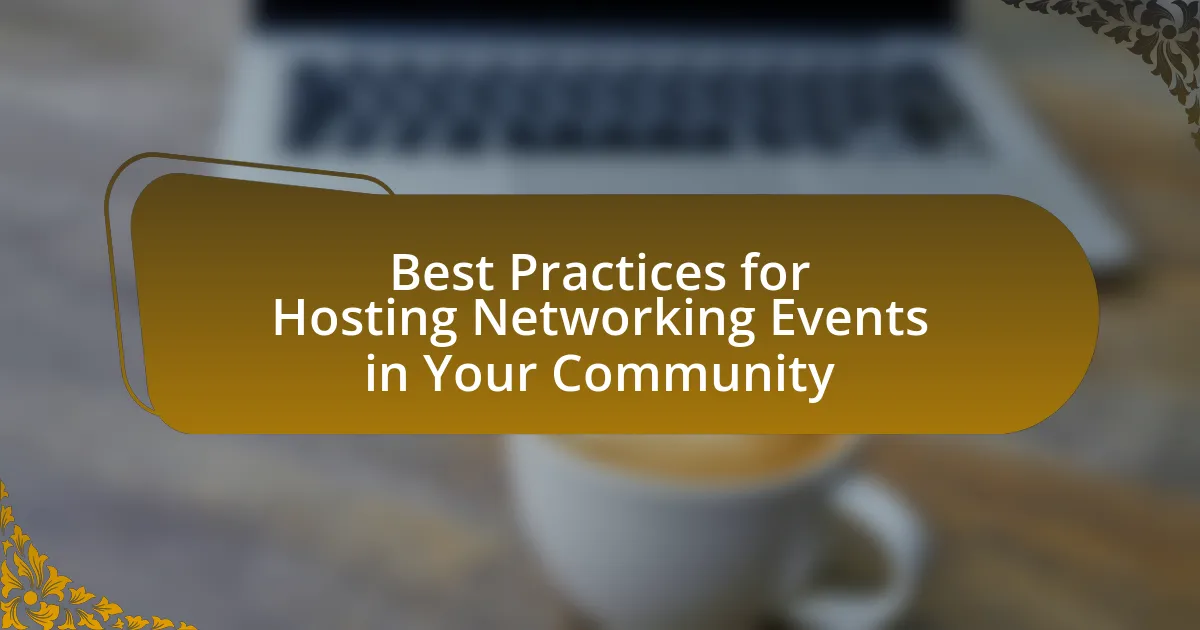The article focuses on best practices for hosting networking events in local communities, emphasizing the importance of defining clear objectives, selecting suitable venues, and promoting events effectively. Key strategies include facilitating meaningful interactions through structured activities, enhancing attendee engagement with interactive elements, and ensuring inclusivity and accessibility. The article also outlines essential steps in the event planning process, logistical considerations, and methods for measuring event success through attendee feedback and performance indicators. By following these guidelines, organizers can create successful networking events that foster valuable connections among participants.

What are the Best Practices for Hosting Networking Events in Your Community?
The best practices for hosting networking events in your community include defining clear objectives, selecting an appropriate venue, promoting the event effectively, and facilitating meaningful interactions among attendees. Clear objectives guide the planning process and help measure success; for instance, a goal could be to connect local entrepreneurs with potential investors. Choosing a venue that is accessible and conducive to networking, such as a community center or local café, enhances participation. Effective promotion through social media, local newsletters, and community boards can increase attendance; studies show that targeted marketing can boost event turnout by up to 50%. Finally, incorporating structured activities like icebreakers or discussion panels encourages engagement and helps attendees connect on a deeper level, which is crucial for successful networking.
How can you effectively plan a networking event?
To effectively plan a networking event, start by defining clear objectives that align with the interests of your target audience. Establishing specific goals, such as fostering connections among professionals in a particular industry or facilitating knowledge sharing, will guide the planning process. Research indicates that events with defined purposes attract more engaged participants, as seen in a study by the Event Marketing Institute, which found that 84% of attendees prefer events that have a clear focus.
Next, select an appropriate venue that accommodates the expected number of attendees and provides a conducive environment for networking. Factors such as location, accessibility, and amenities play a crucial role in attendee satisfaction. According to a survey by Eventbrite, 70% of event organizers believe that the venue significantly impacts the overall experience.
Finally, promote the event through targeted marketing strategies, utilizing social media, email campaigns, and partnerships with local organizations to reach potential attendees. Effective promotion increases visibility and attendance, as evidenced by research from HubSpot, which shows that 61% of marketers consider social media to be the most effective channel for event promotion.
What are the key steps in the event planning process?
The key steps in the event planning process include defining the event’s purpose, setting a budget, selecting a date and venue, creating a guest list, organizing logistics, promoting the event, and evaluating its success afterward. Each step is crucial for ensuring a well-structured and successful event. For instance, defining the event’s purpose helps in aligning all subsequent decisions, while setting a budget ensures that financial resources are allocated effectively. Selecting a date and venue is essential for accommodating attendees, and organizing logistics covers aspects like catering, technology, and transportation. Promoting the event increases attendance, and evaluating its success provides insights for future improvements.
How do you determine the right venue for your event?
To determine the right venue for your event, assess the specific needs of your event, including capacity, location, amenities, and budget. The venue must accommodate the expected number of attendees comfortably, ideally located for accessibility, and equipped with necessary facilities such as audio-visual equipment and catering options. According to a survey by Eventbrite, 70% of event organizers prioritize venue accessibility and amenities when selecting a location, highlighting the importance of these factors in ensuring a successful event.
What strategies can enhance attendee engagement?
To enhance attendee engagement, interactive activities such as workshops, breakout sessions, and live polls should be implemented. These strategies encourage participation and foster a sense of community among attendees. Research indicates that events incorporating interactive elements see a 70% increase in attendee satisfaction compared to traditional formats. Additionally, utilizing technology like event apps for networking and feedback can further boost engagement, as 80% of attendees prefer using mobile devices for event-related interactions.
How can you create an inviting atmosphere for networking?
To create an inviting atmosphere for networking, ensure the environment is comfortable and conducive to conversation. This can be achieved by selecting a spacious venue with adequate seating arrangements, good lighting, and a welcoming decor that encourages interaction. Research indicates that environments with soft seating and open layouts facilitate better communication and networking opportunities, as they reduce barriers between individuals. Additionally, providing refreshments can enhance the atmosphere, making attendees feel more relaxed and open to engaging with others.
What activities can facilitate meaningful connections among attendees?
Activities that can facilitate meaningful connections among attendees include structured networking sessions, interactive workshops, and team-building exercises. Structured networking sessions, such as speed networking, allow participants to engage in brief, focused conversations, fostering quick connections. Interactive workshops encourage collaboration on shared interests or challenges, promoting deeper discussions and relationship-building. Team-building exercises, like problem-solving tasks, create a sense of camaraderie and trust among attendees, enhancing their ability to connect on a personal level. Research indicates that events incorporating these activities see higher participant satisfaction and engagement, leading to lasting professional relationships.
Why is it important to follow up after the event?
Following up after an event is crucial for maintaining relationships and maximizing the benefits of networking. This practice reinforces connections made during the event, allowing for continued dialogue and collaboration. Research indicates that 80% of sales require five follow-up calls after the meeting, highlighting the importance of persistence in relationship-building. Additionally, timely follow-ups can lead to increased engagement, as 70% of people prefer to receive follow-up communication within a week of an event. Thus, following up not only solidifies the initial interactions but also enhances the potential for future opportunities and partnerships.
What methods can be used for effective post-event communication?
Effective post-event communication can be achieved through methods such as follow-up emails, social media engagement, and surveys. Follow-up emails allow organizers to thank attendees, share event highlights, and provide additional resources, fostering continued engagement. Social media engagement enables real-time interaction and sharing of event content, which can enhance community building. Surveys collect feedback, helping organizers assess the event’s success and identify areas for improvement, thus informing future events. These methods are supported by research indicating that timely communication increases attendee satisfaction and retention rates.
How can feedback improve future networking events?
Feedback can significantly enhance future networking events by identifying strengths and weaknesses in the event’s structure and execution. Gathering participant insights allows organizers to understand what aspects were effective, such as venue choice, agenda relevance, and networking opportunities, while also highlighting areas needing improvement, like timing or facilitation. For instance, a study by the Event Marketing Institute found that 70% of attendees prefer events that incorporate feedback mechanisms, indicating a strong desire for continuous improvement. By systematically analyzing this feedback, organizers can tailor future events to better meet the needs and preferences of participants, ultimately leading to higher satisfaction and engagement levels.

What logistical considerations should be addressed?
Logistical considerations that should be addressed include venue selection, transportation, catering, technology requirements, and scheduling. Venue selection must accommodate the expected number of attendees and provide necessary facilities such as seating and accessibility. Transportation logistics involve ensuring that attendees can easily reach the venue, which may include arranging parking or public transport options. Catering considerations include dietary restrictions and meal options to meet the needs of all participants. Technology requirements encompass audio-visual equipment, Wi-Fi access, and any necessary software for presentations or networking activities. Finally, scheduling must account for the timing of the event to maximize attendance and engagement, considering factors such as local events and holidays.
How do you manage event promotion effectively?
To manage event promotion effectively, utilize a multi-channel marketing strategy that includes social media, email marketing, and local partnerships. This approach ensures a wider reach and engages diverse audiences. For instance, using platforms like Facebook and Instagram can increase visibility, as statistics show that 73% of marketers believe that their efforts through social media marketing have been “somewhat effective” or “very effective” for their business. Additionally, sending targeted emails to your existing contacts can yield a high return on investment, with studies indicating that email marketing has an average ROI of $42 for every dollar spent. Collaborating with local businesses or influencers can further amplify your message, as they can tap into their networks to attract more attendees.
What channels are most effective for promoting networking events?
Social media platforms, email marketing, and community partnerships are the most effective channels for promoting networking events. Social media, particularly LinkedIn and Facebook, allows for targeted outreach to specific professional groups, enhancing visibility and engagement. Email marketing enables direct communication with interested individuals, providing personalized invitations and reminders, which can increase attendance rates. Community partnerships, such as collaborations with local businesses or organizations, can leverage existing networks and resources, further amplifying event promotion. According to a study by Eventbrite, 80% of event organizers find social media to be a crucial tool for promotion, highlighting its effectiveness in reaching potential attendees.
How can social media be leveraged for event marketing?
Social media can be leveraged for event marketing by creating targeted campaigns that engage potential attendees and promote event details. Platforms like Facebook, Instagram, and Twitter allow event organizers to share updates, create event pages, and utilize paid advertising to reach specific demographics. According to a study by Eventbrite, 93% of event creators use social media to promote their events, highlighting its effectiveness in increasing visibility and attendance. Additionally, user-generated content and live updates during the event can enhance engagement and foster community interaction, further amplifying the event’s reach.
What are the essential elements of event registration?
The essential elements of event registration include participant information collection, payment processing, confirmation communication, and data management. Participant information collection typically involves gathering names, contact details, and any specific requirements or preferences. Payment processing ensures that attendees can securely pay for their registration, often through various methods like credit cards or online payment systems. Confirmation communication is crucial for providing attendees with details about the event, such as date, time, location, and any necessary instructions. Data management involves organizing and storing the collected information for future reference and analysis, which can enhance the planning of future events. These elements are vital for ensuring a smooth registration process and a positive experience for attendees.
How can you streamline the registration process for attendees?
To streamline the registration process for attendees, implement an online registration system that allows for easy access and completion. This system should include features such as pre-filled forms for returning attendees, mobile compatibility, and automated confirmation emails. Research indicates that events utilizing online registration can reduce check-in times by up to 50%, enhancing the overall attendee experience. Additionally, integrating payment processing within the registration platform can simplify transactions and minimize errors, further improving efficiency.
What tools can assist in managing registrations and ticketing?
Tools that can assist in managing registrations and ticketing include Eventbrite, Cvent, and Ticketmaster. Eventbrite offers user-friendly interfaces for event creation, ticket sales, and attendee management, making it a popular choice for various events. Cvent provides comprehensive solutions for event planning, including registration, ticketing, and analytics, which are essential for larger events. Ticketmaster specializes in ticket sales for concerts and large events, offering robust features for managing high volumes of ticket transactions. These tools are widely used in the industry, demonstrating their effectiveness in streamlining the registration and ticketing process for networking events.
How do you ensure a smooth event execution?
To ensure a smooth event execution, meticulous planning and organization are essential. This involves creating a detailed timeline that outlines every aspect of the event, from logistics to attendee engagement. For instance, a study by Eventbrite indicates that 70% of successful events are attributed to thorough pre-event planning, which includes securing the venue, coordinating with vendors, and preparing contingency plans for potential issues. Additionally, effective communication with all stakeholders, including team members and participants, is crucial to address any last-minute changes or challenges. By implementing these strategies, event organizers can significantly enhance the likelihood of a seamless event experience.
What roles and responsibilities should be assigned to volunteers or staff?
Volunteers or staff should be assigned roles such as event coordinator, registration manager, logistics support, and outreach specialist. The event coordinator oversees the overall planning and execution of the networking event, ensuring all activities align with the event’s objectives. The registration manager handles participant sign-ups, check-ins, and maintains accurate records of attendees. Logistics support is responsible for managing the venue setup, equipment, and supplies, ensuring everything runs smoothly on the event day. The outreach specialist focuses on promoting the event, engaging with potential attendees, and fostering partnerships with local organizations. These roles are essential for effective event management and contribute to a successful networking experience.
How can you handle unexpected challenges during the event?
To handle unexpected challenges during the event, implement a proactive contingency plan that includes designated roles for team members to address issues as they arise. This approach ensures that everyone is prepared to respond quickly and effectively, minimizing disruption. For instance, having a communication system in place allows for real-time updates and coordination among staff, which is crucial when dealing with unforeseen circumstances such as technical difficulties or last-minute cancellations. Research indicates that events with clear contingency strategies experience 30% fewer disruptions, highlighting the importance of preparation in maintaining a smooth event flow.

What are the common pitfalls to avoid when hosting networking events?
Common pitfalls to avoid when hosting networking events include poor planning, inadequate promotion, and lack of engagement strategies. Poor planning can lead to logistical issues, such as insufficient space or resources, which can detract from the attendee experience. Inadequate promotion results in low attendance; research indicates that events with targeted marketing efforts see up to 50% higher participation rates. Lastly, a lack of engagement strategies can cause attendees to feel disconnected; studies show that interactive elements, such as icebreakers or structured networking activities, significantly enhance participant satisfaction and networking outcomes.
What mistakes can hinder the success of your networking event?
Mistakes that can hinder the success of your networking event include poor planning, inadequate promotion, and lack of clear objectives. Poor planning can lead to logistical issues, such as insufficient space or resources, which can frustrate attendees and diminish their experience. Inadequate promotion results in low attendance, as potential participants may not be aware of the event or its benefits. Additionally, a lack of clear objectives can create confusion about the event’s purpose, making it difficult for attendees to engage meaningfully. According to a study by Eventbrite, 70% of event organizers believe that clear goals are essential for success, highlighting the importance of these factors in achieving a successful networking event.
How can poor planning impact attendee experience?
Poor planning can significantly diminish attendee experience by leading to logistical issues, such as inadequate venue space, insufficient resources, and poorly scheduled activities. For instance, if an event lacks a clear agenda, attendees may feel confused and disengaged, resulting in lower satisfaction levels. Research indicates that 70% of attendees value organization and structure in events, highlighting the importance of effective planning. Additionally, poor planning can result in long wait times and overcrowding, which can frustrate participants and deter them from future events. Thus, the overall impact of poor planning is a negative attendee experience characterized by dissatisfaction and disengagement.
What are the consequences of inadequate promotion?
Inadequate promotion of networking events leads to low attendance and reduced engagement. When events are not effectively marketed, potential participants remain unaware, resulting in missed opportunities for networking and collaboration. According to a study by Eventbrite, 70% of event organizers believe that effective promotion is crucial for achieving attendance goals. Additionally, inadequate promotion can damage the reputation of the event and the organizing body, as repeated low turnout may signal a lack of interest or value in the offerings. This can ultimately hinder future events and diminish community involvement.
How can you ensure inclusivity and diversity at your event?
To ensure inclusivity and diversity at your event, implement a comprehensive outreach strategy that targets underrepresented groups. This involves actively promoting the event through channels that reach diverse communities, such as local organizations, social media platforms, and community centers. Research indicates that events with diverse attendees foster richer networking opportunities and innovation, as highlighted in a study by the Harvard Business Review, which found that diverse teams are 35% more likely to outperform their peers. Additionally, consider accessibility in venue selection and provide accommodations for individuals with disabilities, ensuring that all participants can engage fully.
What practices promote a welcoming environment for all attendees?
Creating a welcoming environment for all attendees involves implementing inclusive practices such as actively promoting diversity, ensuring accessibility, and fostering open communication. Research indicates that events that prioritize diversity and inclusion attract a broader range of participants, enhancing the overall experience. For instance, the 2020 Event Marketing Institute report highlights that 78% of attendees feel more engaged in environments that celebrate diverse backgrounds. Additionally, providing clear signage, accessible venues, and offering materials in multiple languages can significantly improve accessibility, making all attendees feel valued and included. Encouraging feedback through surveys or informal discussions also promotes open communication, allowing organizers to address concerns and adapt practices to better serve the community.
How can you address accessibility concerns for participants?
To address accessibility concerns for participants, ensure that the event venue complies with the Americans with Disabilities Act (ADA) standards, which mandate accessible entrances, restrooms, and seating. Implementing these standards allows individuals with disabilities to navigate the space comfortably. Additionally, providing materials in multiple formats, such as large print or braille, and offering sign language interpreters can further enhance accessibility. Research indicates that 1 in 4 adults in the U.S. has a disability, highlighting the importance of inclusive practices to accommodate diverse needs.
What are the best practices for measuring event success?
The best practices for measuring event success include setting clear objectives, collecting quantitative and qualitative data, and analyzing attendee feedback. Clear objectives provide a benchmark for success, such as attendance numbers, engagement levels, or specific outcomes like partnerships formed. Collecting data can involve metrics such as registration numbers, social media engagement, and post-event surveys. Analyzing attendee feedback through surveys or interviews helps gauge satisfaction and areas for improvement. According to a study by Eventbrite, 70% of event organizers who set specific goals reported higher satisfaction with their event outcomes, demonstrating the effectiveness of these practices.
How can you define and track key performance indicators for networking events?
To define and track key performance indicators (KPIs) for networking events, identify specific metrics that align with the event’s objectives, such as attendee engagement, number of connections made, and post-event follow-up responses. For instance, measuring attendee engagement can be done through surveys that assess satisfaction levels and the perceived value of connections made during the event. Tracking the number of connections can involve collecting data on business cards exchanged or digital connections made via platforms like LinkedIn. Additionally, analyzing follow-up responses, such as the percentage of attendees who engage in further communication or collaboration after the event, provides insight into the event’s effectiveness. These metrics are essential for evaluating the success of networking events and guiding future improvements.
What tools can help analyze attendee feedback and engagement levels?
Survey tools such as SurveyMonkey and Google Forms can effectively analyze attendee feedback and engagement levels. These platforms allow event organizers to create customized surveys that can be distributed to attendees post-event, enabling the collection of quantitative and qualitative data. For instance, SurveyMonkey reports that 90% of users find their feedback tools easy to use, which enhances response rates and data accuracy. Additionally, analytics tools like Google Analytics can track engagement metrics on event websites, providing insights into attendee behavior and interaction levels. This combination of survey and analytics tools offers a comprehensive approach to understanding attendee experiences and engagement.
What practical tips can enhance your networking event experience?
To enhance your networking event experience, actively engage with attendees by initiating conversations and asking open-ended questions. This approach fosters meaningful connections and encourages dialogue, which is essential for effective networking. Research indicates that individuals who engage in two-way conversations are more likely to establish lasting professional relationships. Additionally, prepare a concise personal introduction and have business cards ready to facilitate easy exchanges of contact information. Studies show that having a clear personal pitch can increase the likelihood of follow-up interactions by up to 70%. Lastly, follow up with new contacts within 24-48 hours to reinforce connections and express appreciation for their time, as timely follow-ups significantly improve relationship-building outcomes.
